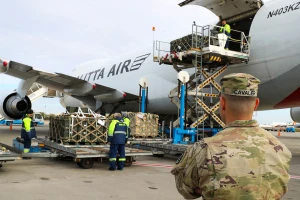
Relentless attacks: Russian army advances in small groups near Avdiivka, tries to gain foothold. Serhiy Zgurets' column
The situation on the front line remains difficult. The number of combat clashes per day exceeds 120. The hottest areas in the east are Bakhmut, Avdiivka and Novopavlivka
Situation at the frontline
In these areas, Russia is now trying to achieve success, using the advantage in manpower, ground equipment, aviation and artillery. The Russian army is making some progress, so the Ukrainian Armed Forces are focusing their efforts on preventing their enemy from turning certain tactical successes into operational ones. To this end, certain stabilization measures are being taken. Nazar Voloshyn, spokesman for the Khortytsia operational-strategic group of troops, said that additional forces had been allocated and reserves deployed in certain areas.
Serhiy Tsehotskyi, an officer of the 59th Separate Motorized Infantry Brigade named after Yakiv Handziuk, spoke about the dynamics of fighting in the Avdiivka direction. According to him, the occupying Russian forces are putting a lot of pressure in the directions of Netailove, Nevelske, Krasnohorivka, actively using a large number of artillery shells, mortars and tanks from closed positions. After all, the Russians are afraid to come out for a direct shot. The assaults are ongoing. Russian troops advance in small groups, try to gain a foothold, and before doing so, destroy everything they can. In such cases, we have to withdraw personnel to save the lives of Ukrainian soldiers. In fact, the situation is very complicated. The command is working to send additional forces. The Ukrainian Armed Forces are waiting for powerful Western weapons that should make it impossible for the Russians to enter operational space.

There are a number of bridges nearby that Russia occasionally tries to strike with its aircraft and bombs. Therefore, there are certain nuances related to the supply of Ukrainian units. There are risks in the process of delivering medical supplies and food, says Tsehotskyi. But the brigade already knows all the possible and impossible moves.
"When the dam of the Karlivka Reservoir in the Donetsk region was destroyed, we also were looking for ways to supply weapons to the front line. So far, there is no threat. But we really need more unmanned aerial vehicles, in particular, FPV drones. This is something we are constantly lacking," he added.
Everyone is involved in countering Russia's offensive, it's a complex job. It all depends on the set tasks. Now counter battles are taking place at the front. The Ukrainian Armed Forces take Russian soldiers prisoner every day. It's hard, but the Ukrainian Armed Forces are doing their job despite the difficulties. The Ukrainian military is working to prevent the Russians from entering the operational space beyond the reservoirs. Only then will the Russian army be able to fulfill its tasks.
The replenishment of personnel on the Ukrainian side continues every day. Soldiers come from training centers. Brigades from other units are also being redeployed and replenished. The Ukrainian Armed Forces are working as hard as they can and fulfilling the tasks set by the command. No one is thinking about motivational factors now, says Tsehotskyi. No one expects any payments for destroyed equipment. The military is happy when something Russian is destroyed, and when they have all the necessary means for this process. The only thing that soldiers from different units are asking for is more FPV drones and ammunition.
Technology and war
In addition to FPV drones, the Ukrainian army uses other technologies, including robotic platforms that operate on the front line. With the help of such platforms, the Ukrainian Armed Forces can mine areas where Russian tanks can move. This is effective and works at a distance of up to 1,000 meters. The Brave1 cluster is working on technologies to ensure that new developments reach the Ukrainian Defense Forces faster.
Vladyslav Kosyanchuk, Head of the Ground Robotic Systems at Brave1, spoke about platform development. According to him, ground robotic systems (GRSs) are a top priority for Brave1. They can take the military off the battlefield. Therefore, the team is actively working on developing this area. Currently, there are more than 200 robotic systems on the Brave1 platform. More than 50 of them have already been tested at the training ground. They have been divided into groups: logistics, evacuation, combat, kamikaze, mining, and demining. These robots were tested. Each of them performed a specific mission and was supervised by the commission. Conclusions and protocols were made that the military will use in the future.
Brave1 provides full support to teams involved in the development and production of robotic platforms. Brave1 assists at every stage, from providing grants to codifying these developments to NATO standards. They are looking for investors and talent to join production teams. They provide testing of these robots at training grounds. They also help to get feedback from the military, who use these robotic systems on the front line. Then they help implement all the recommendations. Thus, a certain market is being created with the help of Brave1, manufacturers, the military, and everyone involved in this process.
Development of the GRS
All the experience gained on the battlefield while using the GRS is collected by the General Staff of the Ukrainian Armed Forces. It is then shared with all troops that may also use these systems in the future. Thus, all the needs will be taken into account in the production of the next generations of the GRS. Since the field of electronic warfare is fairly new, all experience is taken into account. It can be both foreign and Ukrainian processing. Everything works in a complex. Therefore, the more experience we have, the faster the developments will progress and help to withdraw the military from the battlefield.
Both the situation on the battlefield and the needs for robots, their functions and volumes are constantly changing. Options such as the ability of the platform to float or perform combat missions at night are already being introduced by manufacturers, and they are modernizing it, Kosyanchuk said.
- News











































